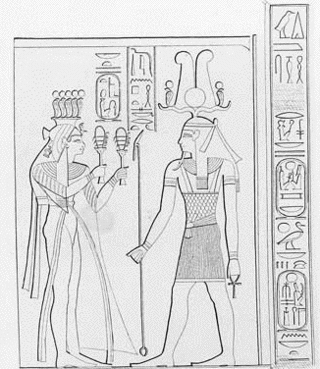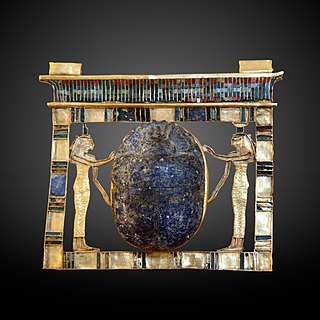
Memphis, or Men-nefer, was the ancient capital of Inebu-hedj, the first nome of Lower Egypt that was known as mḥw ("North"). Its ruins are located in the vicinity of the present-day village of Mit Rahina, in markaz (county) Badrashin, Giza, Egypt. This modern name is probably derived from the late Ancient Egyptian name for Memphis mjt-rhnt meaning "Road of the Ram-Headed Sphinxes".

Saqqara, also spelled Sakkara or Saccara in English, is an Egyptian village in the markaz (county) of Badrashin in the Giza Governorate, that contains ancient burial grounds of Egyptian royalty, serving as the necropolis for the ancient Egyptian capital, Memphis. Saqqara contains numerous pyramids, including the Pyramid of Djoser, sometimes referred to as the Step Tomb, and a number of mastaba tombs. Located some 30 km (19 mi) south of modern-day Cairo, Saqqara covers an area of around 7 by 1.5 km.

Menpehtyre Ramesses I was the founding pharaoh of ancient Egypt's 19th Dynasty. The dates for his short reign are not completely known but the timeline of late 1292–1290 BC is frequently cited as well as 1295–1294 BC. While Ramesses I was the founder of the 19th Dynasty, his brief reign mainly serves to mark the transition between the reign of Horemheb, who had stabilized Egypt in the late 18th Dynasty, and the rule of the powerful pharaohs of his own dynasty, in particular his son Seti I, and grandson Ramesses II.

Usermaatre Setepenamun Osorkon II was the fifth king of the Twenty-second Dynasty of Ancient Egypt and the son of King Takelot I and Queen Kapes. He ruled Egypt from approximately 872 BC to 837 BC from Tanis, the capital of that dynasty.
Prince Khaemweset was the fourth son of Ramesses II and the second son by his queen Isetnofret. His contributions to Egyptian society were remembered for centuries after his death. Khaemweset has been described as "the first Egyptologist" due to his efforts in identifying and restoring historic buildings, tombs and temples.
Merit-Ptah was thought to be a female chief physician of the pharaoh's court during the Second Dynasty of Egypt, c. 2700 BCE; she is purportedly referred as such on an inscription left on her grave at Saqqara by her son.

Thutmose was the eldest son of Pharaoh Amenhotep III and Queen Tiye, who lived during the Eighteenth Dynasty of Egypt. His early death led to the reign of Akhenaten, his younger brother—as the successor to the Egyptian throne—and the intrigues of the century leading up to Ramesses II, the start and ultimately the failure of Atenism, the Amarna letters, and the changing roles of the kingdom's powers.

Karomama I was an Egyptian queen, married to Osorkon II. She was part of the Twenty-second Dynasty of Egypt.

Iset Ta-Hemdjert or Isis Ta-Hemdjert, simply called Isis in her tomb, was an ancient Egyptian queen of the Twentieth Dynasty; the Great Royal Wife of Ramesses III and the Royal Mother of Ramesses VI.

Khaemwaset or Khaemwase was an ancient Egyptian prince, a son of Pharaoh Ramesses III. His name can also be found as Ramesses Khaemwaset.

Paser was an ancient Egyptian noble who served as vizier during the reigns of Seti I and Ramesses II in the 19th Dynasty. He would later also become High Priest of Amun.

The High Priest of Ptah was sometimes referred to as "the Greatest of the Directors of Craftsmanship". This title refers to Ptah as the patron god of the craftsmen.
Sabu also called Tjety was the High Priest of Ptah in the Sixth Dynasty of Ancient Egypt, around 2300 BC. Sabu is mainly known from the remains of his mastaba in Saqqara (E.3). The inscriptions on the fragment of a false door were copied in the 19th century and present part of a biography. The fragments are today in the Egyptian Museum in Cairo. Sabu bears several titles including: Greatest of the Directors of the Craftsmen in the two houses, chief lector priest, sole friend and count.

Pahemnetjer(p3-ḥm-nṯr; "servant of the god", "priest") was a High Priest of Ptah during the reign of Ramesses II. Pahemnetjer succeeded Huy as High Priest of Ptah and was in turn succeeded by his son Didia.

Sehetepebreankh-nedjem was an ancient Egyptian official with the titles royal sealer, foremost of action, Sem-priest and Great one of the leaders of craftsmen. The latter title is that of the High Priest of Ptah. The god Ptah was the deity of arts and crafts and therefore, the high priest of Ptah had a title related to crafts. Sehetepebreankh-nedjem is known from a group statue showing him, his son and his grandson. The statue was dedicated by his son Nebpu, who was also High Priest of Ptah. The statue is datable by style to the end of the Twelfth Dynasty and is now in the Louvre. The statue was bought in 1816 by the Louvre and is most likely from Memphis. This city was the major cult centre for Ptah.

The ancient Egyptian noble Prehotep II was Vizier in the latter part of the reign of Ramesses II, during the 19th Dynasty.

Wendjebauendjed was an ancient Egyptian general, high dignitary and high priest during the reign of pharaoh Psusennes I of the 21st Dynasty. He is mainly known for his intact tomb found by Pierre Montet inside the royal necropolis of Tanis in a chamber of Psusennes I's tomb.
Wahtye was a high-ranking priest and official who served under King Neferirkare Kakai during the Fifth Dynasty of Egypt. Based on his skull, he was probably 35-years-old when he died.
Meryptah was an Ancient Egyptian priest at the end of the 18th Dynasty. He was High Priest of Ptah and therefore the most important religious official at the Ptah temple at Memphis, the capital of Egypt at that time.














